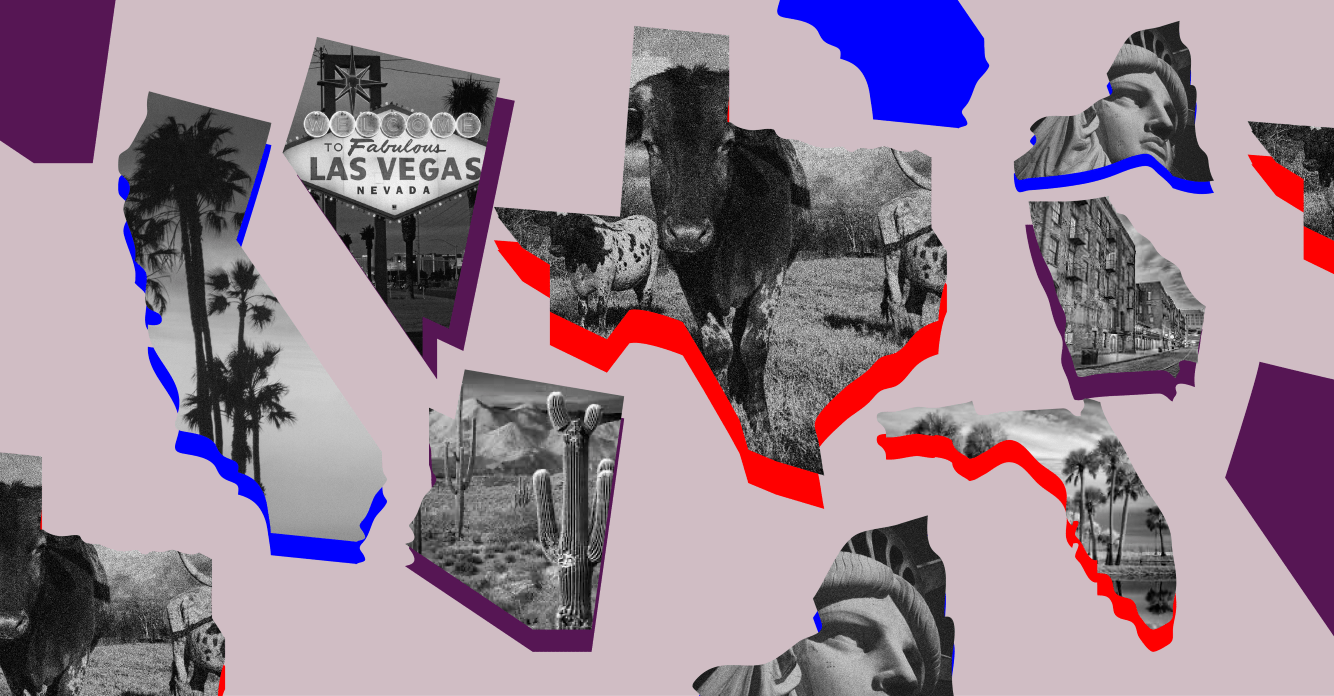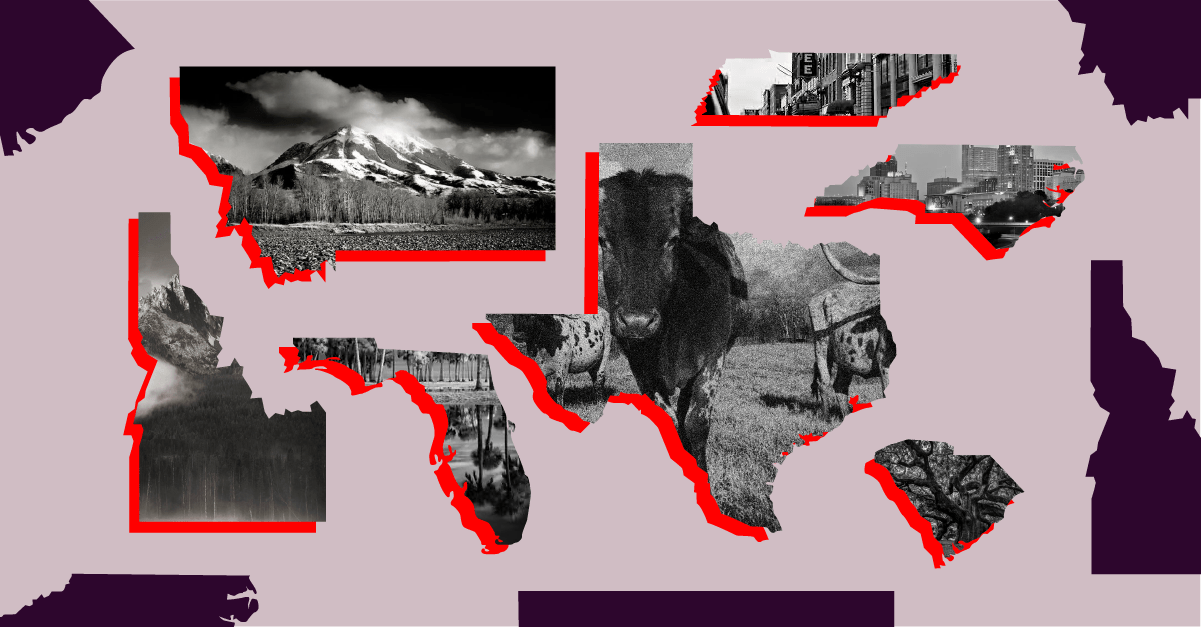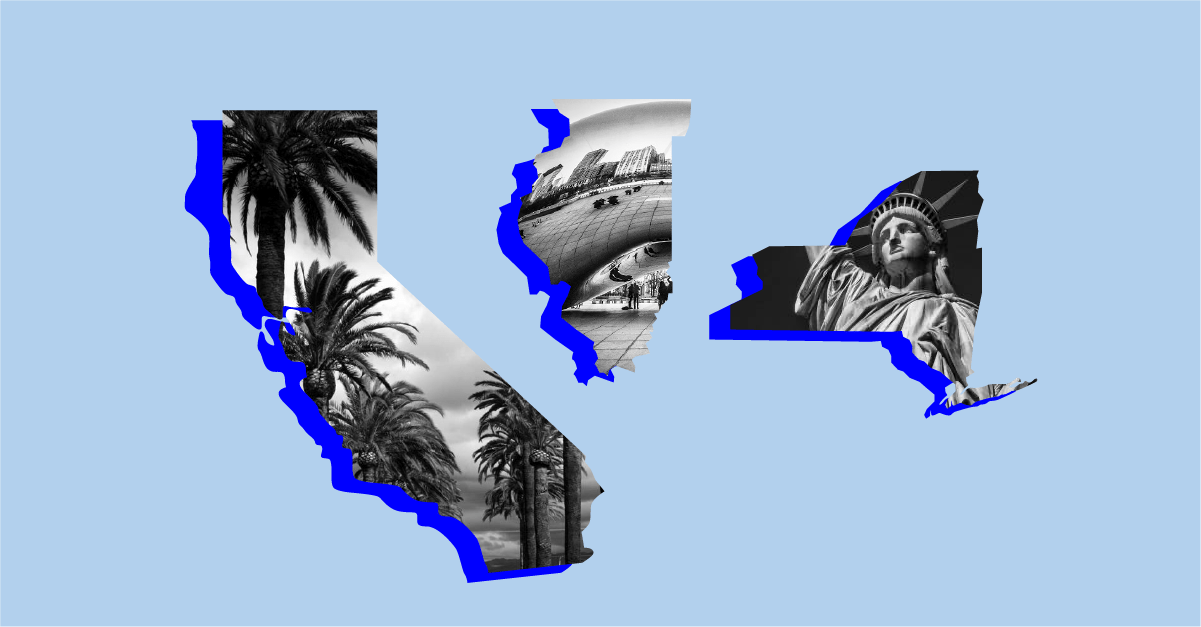Can America’s Moves Swing the 2024 Election?

Will recent moves across state lines decide this year’s presidency?
After all, just about 13% of Americans move yearly, and almost 20% are between states. According to our calculations, that means roughly 30 million Americans have moved to a new state since the 2020 election.
Spread that across 50 states, and migrations can shift elections.
We saw this happen in the 2020 presidential election when 29% of voters were new to their state voting rolls. “We saw move interest surge out of large urban areas in 2020 just ahead of the presidential election,” says moveBuddha’s Ryan Carrigan. “Moves largely went to smaller urban areas in redder states.”
What about this year? Looking at moveBuddha’s mover search data collected since the last election, we found which states will experience an internal shake-up due to a tsunami influx of new residents—and how this could impact the upcoming presidential election.
Key Takeaways
- Arizona, Nevada, and Georgia: The battleground swing states. These swing states drawing in new residents to their urban blue islands may be swinging blue in 2024.
- Wisconsin, Michigan, and Pennsylvania: Swing states with stagnating in-moves will not have their 2024 election numbers changed by migration.
- Job growth and strong economies mean red states keep growing and winning electoral seats, and only some will keep their conservative identities
- Blue states are losing seats and population but getting deeper blue
Does Your State Have Blue Islands? They’re Key To Tipping Elections

One big way that internal migration could impact the 2024 election is in states where the battle between Democrats and Republicans is already close — and which are growing because new residents are pouring in.
So, which of the nation’s purple states have been hot on movers’ lists since the last election?
Of this year’s battleground states, Nevada, Georgia, and Arizona have been some of the top move-to states of the past 4 years.
Election watchers might wonder if a state’s new residents can sway its political base (and not be swayed by it).
The key is “blue islands.”
What’s a blue island? It’s a Democratic pocket in an otherwise Republican area. Large cities are more likely to lean Democratic than their rural counterparts, so the island effect is evident in states that heavily lean red, where Democratic voters cluster in cities like Nashville in Tennessee (where voting districts were split up to eliminate the threat), or Austin in Texas.
To grow, a blue island has to be large enough to support a diverse economy and accommodate new residents, like Atlanta, Las Vegas, and Phoenix. All three are their swing state’s biggest economic hubs. Phoenix alone boasts more than a million more people than the state’s second-largest city, Tucson. Perhaps because of the sheer people-power of their blue islands, these three swing states have seen progressives make state-level inroads since 2012.
Blue Islands Sway Their States with Jobs and Cheap Housing
States with powerful blue islands share more than simply being left-leaning urban areas in right-leaning states, where progressives have made inroads since 2012.
They’re all in the top ten for job growth.
That means these positions are likely being filled by newcomers to these cities.
Not coincidentally, Georgia, Nevada, and Arizona are all swing states that were instrumental in deciding the 2020 election. In Georgia, interstate moves to Atlanta were instrumental in shifting the 2020 election to Biden.
Ironically, blue islands might benefit from lax state-level business regulation, which lets them grow into large-scale job magnets for their states. That entices young, educated in-migration. Since both Gen Z and Millennials, as well as those with college degrees, are more likely to vote blue, new workers in blue island cities grow a state’s Democratic base.
Movers are flocking to strong economies with affordable housing costs and job opportunities.
That means that at the state level, many of the “red” moves are actually trending “green,” as new residents say yes to new financial opportunities and homeownership in up-and-coming cities.
Consider the example of Arizona, a “swing state” thanks to Joe Biden’s narrow victory in the 2020 election. Biden was the state’s first Democratic presidential pick since 1948. Today, Arizona is even more poised to vote blue due to high in-migration from those wowed by its growing economy. Arizona is:
- #10 for GDP growth from Q3 2020 to Q3 2023
- #5 for job growth from Jan 2020 to Jan 2024
- #5 for building permits per capita in 2023
Some analyses also point to “priced-out” Californians and Washingtonians as a reason Arizona has passed recent progressive legislation. Ultimately, where economic prosperity brings young, urban workers pushed out of democratic strongholds by the high cost of living, those young, urban workers bring Democratic votes.
Midwestern Swing States Swing Less
The same swing power doesn’t apply to Midwestern swing states Michigan, Pennsylvania, and Wisconsin. moveBuddha data shows that all three have had more moves exiting than moving in since 2020, especially in Michigan and Pennsylvania.
That has resulted in a net loss of electoral seats for Michigan and Pennsylvania following the 2020 census.
Because interstate moves are likely to prioritize jobs, family, and cost of living rather than politics, moving influx favors red states but likely doesn’t supply them with solely red residents.
While a mixed political bag of residents exits these Midwestern swing states, no newcomers arrive, leaving their internal demographics mostly unchanged.
That’s down to the economic fates of the Midwest. Housing costs in the lower half of states might attract incoming grads looking to live better on the cheap. But that’s not much use when job creation is also in the bottom half of states. GDP growth is also in the bottom half.
All three states traditionally comprise the “blue wall” where Democrats have dominated politics. Yet all have seen more of their residents embrace populism as the Republican party and Donald Trump win over working-class voters. While they’re still important battleground states in 2024, it’s not because a wall of new residents is changing the game.
Seeing Red: Moves to Red States Still Going Strong

The states grabbing the most new residents are staunchly red.
For moves spanning 2020 to 2024, just 1 blue state appears in the top eight for most in-moves versus out-moves: Maine (20 electoral votes, split).
Conversely, among the top states for out-moves, the 8 largest losers since 2020 are all blue: California lost the most people compared to in-moves, followed by New Jersey, Illinois, Maryland, Connecticut, Rhode Island, New York, and Massachusetts.
However, research suggests that those deep blue-state goodbyes aren’t necessarily Democrats. Instead, they may be Republican residents self-sorting to locales where they feel they’ll be more welcome.
For instance, movers from Washington to Idaho have overwhelmingly registered to vote as Republicans in their new state, turning the state even more Republican (and making it harder for Republicans in Washington to edge out Democrats in future elections). Further, there are no “blue islands” in Idaho where urban workers find their perfect neighborhood—just three counties in Idaho went blue in the 2020 election, and none include the state’s most populous cities like Boise, Pocatello, or Idaho Falls.
For states like Idaho, the wave of new Republican residents won’t change elections. As the Republican candidate, Donald Trump already won Idaho by almost 31% in 2020. Adding to his lead is simply icing on the cake for Republican Idahoans.
Are Red States Holding Onto their Red Identities Better?
If red states are earning more blue and red residents, why aren’t they turning bluer? There are some reasons:
- Economics is political. Movers seeking a business-friendly environment and low taxes are likely self-sorting into Republican states.
- More voters are registering as Republicans, including movers who are taking on the identities of their new locales, or those simply registering as Republicans so they can have a voice in red-state primaries.
- Republican states tend to be sunbelt states that attract older retirees, who lean more Republican than other demographics, solidifying the state’s existing political leanings.
- Entrenched state cultures are tough to change but easy to join. Newcomers may be adopting their new neighbors’ culture rather than swaying it.
South Carolina, the second-top move-in state from 2020 to 2024, is a prime example. With more than twice the number of people moving in than moving out from 2020 to March 2024, it’s a conservative behemoth that’s only getting bigger, and it has done so while keeping its Republican tilt.
While South Carolina is #2 in in-moves, it may be retaining its Republican identity because it fares a little worse on dimensions of economic growth, suggesting it’s not attracting as many young, urban workers as other states. In fact, there is plenty of evidence it’s attracting a retirement crowd eager to enjoy its beaches and mild weather. And while it’s growing, its GDP growth in the past 4 years has not kept pace with population growth, coming in 18th. Similarly, job growth over the same period lags compared to other top-growth regions at 11th place.
In the end, it may not be simply that a state wins new movers that shift its politics. Political change may be linked more closely to what kinds of movers they attract.
Blue States Lose Electoral Votes But See a Silver Lining

A flip-flop from red to blue would be the end of the story if moves from blue states were all Democrats moving their vote to a new locale.
But it’s not an equal trade.
Many young movers are actually Democrats heading to jobs in blue cities in red states. Republicans are also heading to red states. Ditto retirees seeking sunshine, those seeking a safer environment, and those chasing affordability.
Regardless of their political leanings, red states are the big relocation winners, while blue states are attracting a narrower band of newcomers.
Overall, Republicans are losing ground in existing blue states. With an exodus of voters, they may never get it back.
The blue states are staying blue, though losing electoral votes. The attractive economics in top-move cities suggest that red states will gain the electoral votes that blue states are losing…for now, as blue state populations get smaller and older, but don’t draw new residents.
For instance, the top seven states for GDP growth since 2020 are red.
8 have seen positive inflow since 2020, and a clear overlap with top move-in destinations like: Tennessee, Texas, Florida, and Idaho. This suggests movers are moving for opportunities above politics. However, it also means the political tide will favor red states with strong economies.
| State | State GDP growth from 2020 to 2023 | In-to-out move ratio 2020- 2024 |
| Tennessee | 15.8% | 1.73 |
| Texas | 15.8% | 1.43 |
| Florida | 15.7% | 1.55 |
| Nebraska | 12.5% | 0.84 |
| Idaho | 11.5% | 1.79 |
| Utah | 11.0% | 1.00 |
| Wyoming | 10.3% | 1.55 |
| Maine | 10.3% | 1.96 |
| Nevada | 10.0% | 1.19 |
| Arizona | 10.0% | 1.17 |
But blue states have a lot to be thankful for.
With fewer residents, Democrat-backed policies hoping to spread more resources to more residents will get easier.
Residents in blue states already live longer lives than their red-state counterparts, and that advantage might be attributed to political policies from education to healthcare.
So, as red states amass electoral seats at the federal level, state-level Democrats in blue states may see their work gain traction, attracting newcomers in the future.
They’re already seeing benefits.
“Red state brain drain” has meant that educated movers are more likely to head for blue states. Applications for academic positions are down in red state universities, for example, and applications for ob-gyn residencies are down in states where abortion has been outlawed.
The impact of highly skilled workers bucking the low-cost migration trend (heading to popular blue-state cities like Olympia, Washington, or Eugene, Oregon) doesn’t make up for the number of lost blue-state electoral votes, but it does bode well for the caliber of services these states might provide and their future well-being, including the inventions they may come to support in new business starts and the health and welfare of their residents.
In 2024, More Swing States Will Be Swinging the Blues
Our 2024 prediction: Deep red states without large cities will continue to get redder, deep blue states will get bluer than ever, and purple states with large job influxes in urban hubs could easily go blue.
Those seeing retirees and sluggish job growth compared to their rate of in-moves? They’re holding on to their red state credentials.
“Ultimately, most red states are staying red while most blue states are staying blue. But in a handful of states, moves matter. And moves from out of state will matter a lot in this year’s election, especially in Georgia, Nevada, and Arizona.” – Ryan Carrigan, moveBuddha
In the end, changing the politics of a state means changing its demographics, not just its population. And states where Gen Z and Millennial workers are making their homes in urban economic centers will have to reckon with changing political tides.
As blue states have found, it’s hard to grow when young people can’t afford to start their lives in your state. And as red states are soon to discover, it’s hard to stay red when your low prices, high job growth, and growing-city vibes are the perfect place for young adults.
Not what you were looking for?
Check out other categories that can help you find the information you need!

